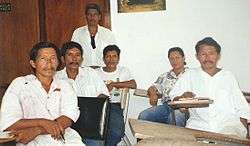Lokono
| Total population | |
|---|---|
| 10,000[1] | |
| Regions with significant populations | |
| Languages | |
| Arawak |
The Lokono or Arawak are an Arawak people native to northern coastal areas of South America. Today, approximately 10,000 Lokono live primarily along the coasts and rivers of Venezuela, Guyana, Suriname, and French Guyana. They speak the Arawak language, the eponymous language of the Arawakan family.
Name

Historically, the group self-identified as "Arawak", which also became the usual name outsiders called them. In the 19th century, when Western scholars had established that the major population of the Caribbean during European contact (now known as the Taíno) were culturally and linguistically related to the South American Arawak, ethnologist Daniel Garrison Brinton proposed calling the Caribbean people "Island Arawak". Subsequent scholars shortened this convention to simply "Arawak", thereby causing confusion with the mainland people. In the 20th century, scholars such as Irving Rouse began using the older term Taíno for the Caribbean group to distinguish them from mainlanders. The mainland Arawak also call themselves "Lokono" (also spelled "Locono" and "Lokomo"); this has become more common in scholarly literature as well.[2][3]
History
The Arawakan languages may have emerged in the Orinoco River Valley, and subsequently spread widely, becoming the region's most widely spread language family by the time of European contact.[4] The group that self-identified as the Arawak or Lokono settled the coastal areas of what is now Guyana, Suriname, French Guiana, and parts of the island of Trinidad.[2][3]
While the Spanish were quick to colonize the Caribbean, the Lokono and other mainland peoples were able to resist colonization for a much longer period. The Spanish were unable to subdue them throughout the 16th century. However, with increased encroachment from other European powers in the early 17th century, the Lokono allied with Spain against the neighboring Kalina (Caribs), who themselves allied with the English and Dutch.[5] Subsequently, the Lokono engaged in trading relationships with the Europeans, an arrangement that led to prosperity. However, economic and social changes in the region in the early 19th century, including the end of the plantation economy, affected the Lokono negatively, and their population began to decline. In the 20th century, the Lokomo began to supplement their traditional agricultural economy by selling fish and lumber and through migrant labor, and their population has begun to rise again. There are approximately 10,000 Lokono living in Venezuela, Guyana, Suriname, and French Guiana, and thousands of others with Lokono ancestry.[1]
References
- 1 2 Olson, James Stewart (1991). The Indians of Central and South America: An Ethnohistorical Dictionary. Greenwood. p. 211. ISBN 0313263876. Retrieved June 16, 2014.
- 1 2 Rouse, Irving (1992). The Tainos. Yale University Press. p. 5. ISBN 0300051816. Retrieved June 16, 2014.
- 1 2 Olson, James Stewart (1991). The Indians of Central and South America: An Ethnohistorical Dictionary. Greenwood. p. 29. ISBN 0313263876. Retrieved June 16, 2014.
- ↑ Hill, Jonathan David; Santos-Granero, Fernando (2002). Comparative Arawakan Histories: Rethinking Language Family and Culture Area in Amazonia. University of Illinois Press. p. 1–4. ISBN 0252073843. Retrieved June 16, 2014.
- ↑ Hill, Jonathan David; Santos-Granero, Fernando (2002). Comparative Arawakan Histories: Rethinking Language Family and Culture Area in Amazonia. University of Illinois Press. p. 39–42. ISBN 0252073843. Retrieved June 16, 2014.